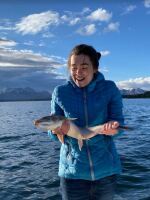This season held several surprises – from huge harvests to thermal barriers and late runs. And 2019’s age composition was no exception. We talk with a biologist from the University of Washington about the unexpected returns from this year and what it means.
Egegik’s harvest went well beyond the pre-season forecast. The last daily run summary put its total harvest at 14.7 million – the largest in the bay this summer, and the third largest harvest in the history of the district.
According to Curry Cunningham, a biologist with the University of Washington, that was due to an unusually high return of age 1-2 fish to the district.
“Our preseason forecast for the Egegik District had about 38% 1-2s,” he explained. “But the observed return exhibited a much higher proportion of 1-2s, so about 74% 1-2s in the catch and 85% 1-2s in the escapement.”
There was a similar pattern in the Nushagak. 1-3s were expected to make up three quarters of the run due to the high 1-2 production last year. That suggests that fish hatched in 2014 had good survival conditions.
“But in reality what we saw in the Nushagak District was a fairly even mix of 1-2s and 1-3s,” Cunningham said.
This is the third year of big returns for 1-2s. Over the past decade, the average return for that age class has been around one third of the total run. But in 2017, the 1-2 return ticked up 53%, and last year that number rose to 58%.
“So we’ve seen over the last three years, basically, higher production of that 1-2 age class, suggesting fish have done fairly well during their first two years at sea, and are returning at two years rather than three years in the ocean,” Cunningham said.
Biologists are still trying to understand why the fish have been doing so well in the ocean. According to Cunningham, warmer freshwater can have a positive effect on survival rates for salmon. Warmer years bring earlier ice-outs, a longer growing season and more food for juvenile salmon. That could increase the size of the young salmon swimming out to sea.
“At a larger size, they might be better able to avoid predators, find food, and may have higher survival overall,” he said.
After a certain point, the temperature can negatively impact survival in both freshwater and marine environments. Still, increased temperature in freshwater habitat has been beneficial for the 1-2s returning over the past three years.
Graveyard Point has been a set-net site for decades, even as the land has changed hands and the once-functional cannery has deteriorated. Now, the Graveyard Point site is undergoing an environmental assessment. On the show, KDLG’s Sage Smiley breaks down what’s going on at Graveyard.
On Tuesday, the EPA threw out proposed restrictions that could have put a stop to the Pebble Mine project. With a potential hurdle out of the way, shares in the company that owns Pebble saw a boost. We hear from KDLG's Alex Hager.

Contact the author at isabelle@kdlg.org 907-842-2200.



